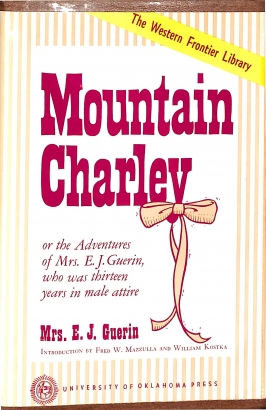From the exploits of Buffalo Bill to the legend of Paul Bunyan, the Old West certainly brought forth its share of legends, both true to life and spurious in nature. For every piece of folklore which gained attention and endured through the years, there were dozens (at least) which fell by the wayside and were lost to the mists of time. One such tale which was almost lost and very nearly forgotten, is the story of Elsa Jane (Forest) Guerin, better known by her alias Mountain Charley.
“Better known” is, of course, a relative term. Though her autobiography was published in 1861, by 1968 there was only one known copy in existence, held by noted railroad enthusiast and collector Everett L. DeGoyer Junior. Intrigued by the story, Denver attorney Fred Mazzula and businessman William Kostka had it reprinted as part of the Western Frontier Library series.
So, who was the titular Mountain Charley? According to her (ostensibly) own words, she was married at age 12. By the time she was 15, she and her husband (whose age is not mentioned, but who was a riverboat pilot) had two children. Around this time, her husband was shot to death by a fellow known only as Jamieson.
Destitute and desperate, Elsa devised a plan. She left her children in the hands of the Sisters of Mercy, disguised herself as a man, and set out to make a living… and perhaps mete out some revenge along the way. Thus began a journey that took her from St. Louis to California and back again (twice), to Pike’s Peak during the heart of the gold rush, and finally to Denver, where she became proprietor of the Mountain Boys Saloon. Eventually, she confronted Jamieson, and both were wounded in the shootout which followed. Elsa (nee Charley) was absolved of wrongdoing in the shooting when Jamieson confessed to killing her husband, and she went on to marry a man named Guerin who was the bartender at her saloon.
That’s how the story goes. Well, one version of it, anyway. In their introduction, Mazzula and Kostka point to certain aspects of the narrative, such as place names and landmarks, which they believe lend credibility to the story. While it certainly indicates that the author had some knowledge of the overland routes west, and the Pike’s Peak region, I’m not sure those warrant confidence that other aspects of the lore are also true. (Buffalo Bill was a real person, but that doesn’t mean the exploits in his dime novels were based in reality.)
Mazzula and Kotska were apparently cognizant of this fact, as well. Following Guerin’s autobiography is the full text of an article originally printed in the January 14, 1885, issue of the Colorado Transcript. The author claimed to have known Mountain Charley personally, and his recounting of events differs significantly from the alleged autobiographical account, including claims that Charley actually enlisted in the Army.
So… how much of this tale is true? Any of it? Perhaps a better question is: Does it matter? Whether factually accurate or not, the saga certainly provides some interesting insight into perceived gender roles during the gold rush, and makes for an entertaining campfire tale, at the very least.
This is just one of the myriad oddities housed in WHG. Feel free to take a look, and don’t forget to like our Facebook page for more intriguing tidbits from the past.



Comments
This was super helpful thank
This was super helpful thank you!!!
Glad to hear it!
Glad to hear it!
Thank you, this was very
Thank you, this was very helpful! ;)
This was helpful.
This was helpful.
was very helpful for my class
was very helpful for my class assignment, thank you!!
she left her children HELP-
she left her children HELP-
helpful thank you very much
helpful thank you very much
thx
thx
Very Noice
Very Noice
Helped me a lot with my…
Helped me a lot with my essay!!! Thank you
Add new comment